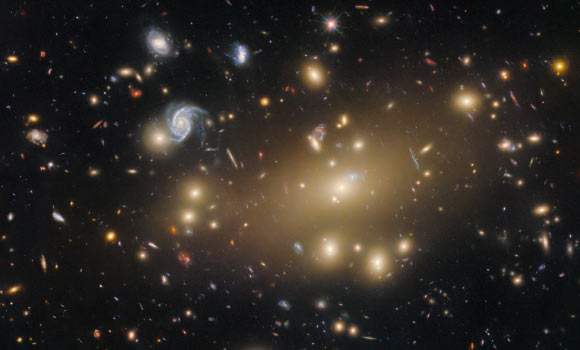Abell 209 is a massive galaxy cluster located about 2.8 billion light-years away in the constellation of Cetus.
This Hubble image shows Abell 209, a galaxy cluster located about 2.8 billion light-years away in the constellation of Cetus. The color image includes both optical and infrared observations from Hubble’s Advanced Camera for Surveys (ACS) and Wide Field Camera 3 (WFC3). Twelve filters were used to sample various wavelengths. The color results from assigning different hues to each monochromatic image associated with an individual filter. Image credit: NASA / ESA / Hubble / M. Postman / P. Kelly.
Galaxy clusters contain thousands of galaxies of all ages, shapes and sizes.
Typically, they have a mass of about one million billion times the mass of the Sun.
At one point in time galaxy clusters were believed to be the largest structures in the Universe — until they were usurped in the 1980s by the discovery of superclusters, which typically contain dozens of galaxy clusters and groups and span hundreds of millions of light-years.
However, galaxy clusters do have one thing to cling on to; superclusters are not held together by gravity, so galaxy clusters still retain the title of the biggest structures in the Universe bound by gravity.
“Abell 209’s galaxies are separated by millions of light-years, and the seemingly empty space between the galaxies is actually filled with hot, diffuse gas that can be spotted only at X-ray wavelengths,” Hubble astronomers said in a statement.
“An even more elusive occupant of this galaxy cluster is dark matter: a form of matter that does not interact with light.”
“The Universe is understood to be comprised of 5% normal matter, 25% dark matter, and 70% dark energy,” they said.
“Hubble observations like the ones used to create this image can help us answer fundamental questions about our Universe, including mysteries surrounding dark matter and dark energy.”
“These investigations leverage the immense mass of a galaxy cluster, which can bend the fabric of spacetime itself and create warped and magnified images of background galaxies and stars in a process called gravitational lensing.”
“While this image lacks the dramatic rings that gravitational lensing can sometimes create, Abell 209 still shows subtle signs of lensing at work, in the form of streaky, slightly curved galaxies within the cluster’s golden glow.”
“By measuring the distortion of these galaxies, astronomers can map the distribution of mass within the cluster, illuminating the underlying cloud of dark matter.”
“This information, which Hubble’s fine resolution and sensitive instruments help to provide, is critical for testing theories of how our Universe has evolved.”
